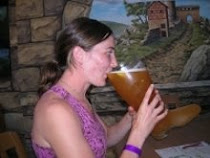A couple months back, John E and I discussed putting together a nice winter ale. While what we experience in North Carolina doesn't really resemble winter, I was up to the challenge.
The "Winter Ale" is not actually a recognized beer category. In fact winter ales generally conform to a few specific characteristics, and can conform to many different particular syles. Winter ales get their name because of their ability to keep the drinker warm when the weather gets cold. They do this with a stronger alchohol content. Winter ales are generally considered more of a sweeter malty beer with lower bitterness. I believe this sweetness will actually add to the warming effect of the beer.
 The style I chose to go with is 18C - Belgian Trippel. The term dubbel, trippel, and quadruple are referring to the amount of malt in the brew. Trippel for example will generally see trippel the amount of fermentable sugars then your regular ale.
The style I chose to go with is 18C - Belgian Trippel. The term dubbel, trippel, and quadruple are referring to the amount of malt in the brew. Trippel for example will generally see trippel the amount of fermentable sugars then your regular ale.
The problem with doing a trippel is that I can only fit about 12lbs of malt into my 5 gal mash tun... so unfortunately I'll have to make up the rest of the sugars using some dried malt extract. Oh well... at least this is reasoning for a larger mash tun down the road! :-) I put together a pretty basic recipe. From what I was gathering online, it seems trippels are at their best when they're simple. As in 2 or 3 types of malts, a few hop additions, and let the yeast do the rest. I decided to just go with pale and munich malts. Munich should add that nice malty flavor I like. I also wanted to up the sugar content using some Belgian candy sugar. Here's the recipe
Amount Item Type % or IBU
2.00 lb Light Dry Extract (8 SRM) Dry Extract 12.90 %
10.00 lb Pilsner (2 Row) Bel (2 SRM) Grain 64.52 %
2.00 lb Munich Malt (9 SRM) Grain 12.90 %
1.00 lb Candi Sugar (Soft), Blonde (5 SRM) Sugar 6.45 %
0.50 lb Candi Sugar (Soft), Brown (40 SRM) Sugar 3.23 %
1.00 oz Tradition [5.70 %] (60 min) Hops 14.7 IBU
1.00 oz Goldings, East Kent [4.80 %] (30 min) Hops 9.5 IBU
1.00 oz Saaz [3.40 %] (7 min) Hops 2.4 IBU
1.00 cup Malto-Dextrine (Boil 5.0 min) -
2 Pkgs Trappist Ale (White Labs #WLP500) Yeast-Ale
Original Gravity: 1.080 (missed target by -.002)
Bitterness: 26.6 IBU
Est Color: 9.3 SRM
Calories: 368 cal/pint
This guy had been bubbling strong every day last week. It finally slowed down a bit, but it's definitely the strongest fermentation I've had on a beer yet. The #WLP500 has been known for it's banana/clove esters. I tried to keep the fermentation temps low, however even with the house at 66 degrees, the ferementation was releasing so much heat that the temperature of the beer was mid 70s!!
I'll be out in Kansas City for the beginning of Feb, but when I get home I'll be bottling up the HCSP from last month.




